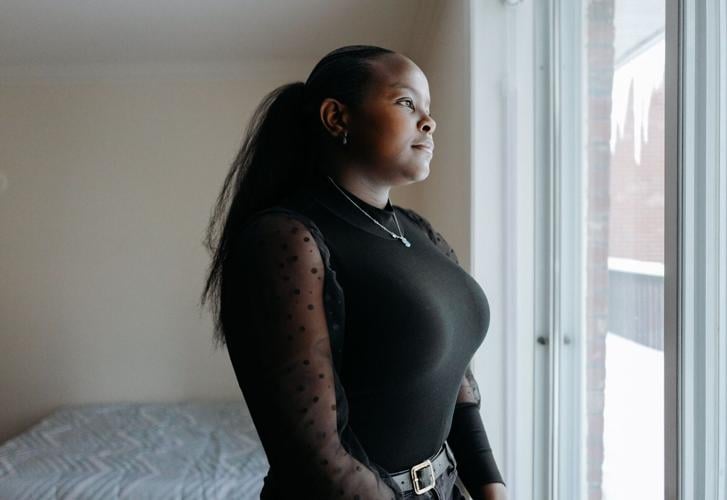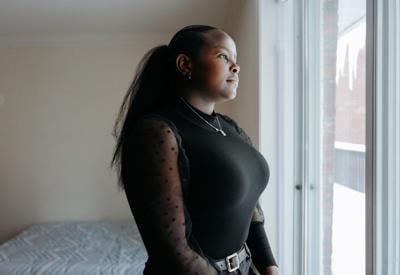Tracy Muriithi had never been away from her family, let alone travelling outside Kenya on her own.
When she landed in É«É«Ŕ˛ in January 2019 after a 20-hour flight via Germany, the then 17-year-old followed the signs to Customs and had no idea what she was supposed to do. She didn’t even have a winter coat. Although she came here on a student visa, there was a darker reason for her travel, and the border guards questioned her.
“They were like, ‘Why are you coming from home? Are you really coming here to study?’ ” recalled Muriithi, now 23.
“I was very scared. I’m going to this new country where I don’t know anything or anyone. The only thing I was banking on was that I could speak a bit of English. And I know my parents are not there to help me because we’re time zones and time zones away.”
The truth was, said Muriithi, her parents sent her to Canada to save her from gender violence back home. And the unaccompanied minor had to navigate a new life and a complex refugee system by herself.
According to the Centre for Refugee Children in É«É«Ŕ˛, each year 400 to 500 unaccompanied and separated children come to Canada for asylum, about half of them destined for Ontario. They flee conflict zones and persecution based on race and ethnicity, as well as family violence. Their parents often don’t have the resources to get the whole family out, and make a bid to keep their children safe.
While helping these minors with school enrolment, income support and refugee claim process are all important, finding them a safe place to stay is an immediate challenge, said Steve Meagher, director of the centre, which was founded in 2021 to provide specialized support to unaccompanied and separated refugee children.
That’s what prompted the organization this month to open Anchor House — a five-room, 12-bed facility at an undisclosed location in the city to house newly arrived minor refugees who are here on their own. It’s believed to be the first emergency housing in Canada dedicated to unaccompanied refugee children and youth.
While unaccompanied claimants under 16 are referred by immigration and border authorities to the Children’s Aid Society and placed in foster care, the 16- and 17-year-olds often find their way in regular homeless shelters or stay with in the community. Those settings are not designed to meet their unique needs, said Meagher.
He estimates that about 15 per cent of unaccompanied minors stay in homeless shelters with another 15 per cent in foster care placements. The remaining 70 per cent are housed by relatives and acquaintances.
“What we often find with children is that the kind of trajectory of their refugee claim is often determined from those first decisions and the most first steps,” said Meagher.
“It’s really important that children are supported, that they understand what their rights are and what resources are available to them. If not, they are quite a vulnerable population and they can be taken advantage of or given incorrect information.”
Refugee youth, already coping with past trauma and family separation, can be overwhelmed by the new environment and culture, during what can be a stressful asylum process. Some face language barriers when accessing support.
“We want to create a safe haven when they arrive,” said Feven Iket, Anchor House’s site co-ordinator. “We want to create a space where they feel at home, a space where they feel settled. Loneliness is the hardest part for them all.”
Adam fled war in Sudan, and his older brother was killed after they were separated from their parents and siblings. He finally arrived alone in Vancouver in December 2023 after a long journey through Chad, Turkey, Colombia, El Salvador and Nicaragua.
“It was very scary when I was travelling across those countries,” said the now 18-year-old, who asked that his last name be withheld while he’s trying to secure his permanent residence in Canada. “I was afraid police would catch me. I couldn’t think of what’s going to happen next.”
Knowing a bit of French, but no English, the then 17-year-old initially stayed in a homeless shelter and decided to take a train to Montreal. But he ran out of money and only made it to É«É«Ŕ˛. He went to a mosque for help, and a compatriot directed him to the Centre for Refugee Children.
He was able to continue his education in Grade 11 and stayed at a refugee shelter before moving out to a shared apartment, with meagre social assistance. He tries to work whenever he can but uses the food bank when money is tight.

Adam, 18, who came in 2023 from Sudan, is pictured silhouetted at the dining table of Anchor House.Â
Michelle Mengsu Chang/É«É«Ŕ˛ Star“It’s been difficult but I’ve survived,” said Adam, who finally tracked down his parents and 13 siblings at a refugee camp in Chad last year. “I just need to be somewhere safe.”
Adam said he hopes to study engineering in university when he finishes high school this summer.
Nestled in a residential neighbourhood, the three-storey Anchor House has an intake office; a cosy family room with a sectional couch, big TV and fireplace; a bright study/activity room with four desktop computers, desks and bookshelves; and a huge communal kitchen on the ground floor.
The second floor has four bedrooms for boys, each with two single beds and night tables. There’s a much bigger ensuite for four girls, with similar set-ups.
A staff member is on site at all hours to supervise residents, who get help in their asylum claim, enrolling in school, applying for government assistance and accessing health care through a case management team. The residents are provided with food at the house, though they are responsible for cleaning.
Muriithi, who graduated with a bachelor’s degree in commerce from É«É«Ŕ˛ Metropolitan University last year, said she wished she didn’t have to figure things out the hard way.
After her initial stay with a friend of a family friend, she met a woman at a church who took her in. She turned to the internet for information to navigate her life and knocked on the door of a youth shelter for guidance. Although she had a lawyer through legal aid, she was on her own through the asylum process without help in decision making.
Muriithi now works as a real estate agent and a co-ordinator of a youth-led project to improve the system for unaccompanied claimants.
Anchor House is more than a shelter, she said. “If you’re living with other people who are unaccompanied minors to the country, you get a sense of belonging. You are not alone in this.”Â































To join the conversation set a first and last name in your user profile.
Sign in or register for free to join the Conversation